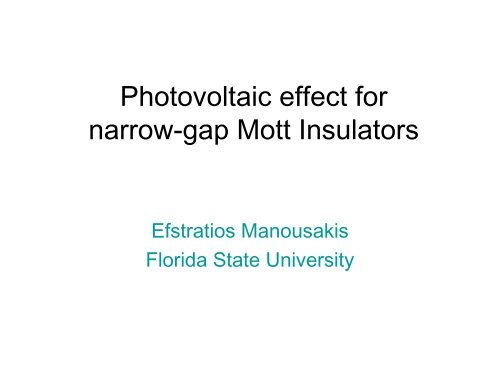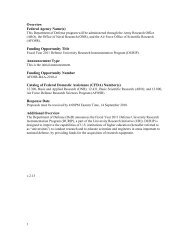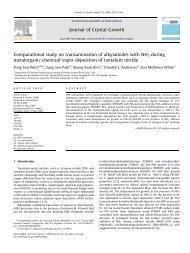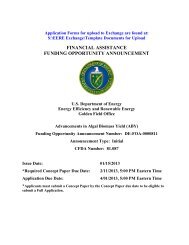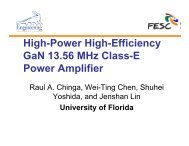Photovoltaic effect for narrow-gap Mott Insulators - Florida Energy ...
Photovoltaic effect for narrow-gap Mott Insulators - Florida Energy ...
Photovoltaic effect for narrow-gap Mott Insulators - Florida Energy ...
You also want an ePaper? Increase the reach of your titles
YUMPU automatically turns print PDFs into web optimized ePapers that Google loves.
The <strong>Mott</strong> insulatorHˆ t c c U nˆ nˆij†ijiii
<strong>Photovoltaic</strong> <strong>effect</strong> in <strong>narrow</strong>-band<strong>narrow</strong>-<strong>gap</strong> <strong>Mott</strong> Insulator
As a perturbative process
kd*2 cos( )1E t k a1/WThe value of Z is calculated usingthe strong U limit of Hubbardi.e, the t-J modelTake V=U=1 eV, t=1/4For these valueJ/t=4t/U=1 and W=0.96 t, Z=0.53i.e. W=0.24 eV =0.9x10 15 sec -1which is much larger than decayvia phonon emission or phononscattering.
What is wrong with a band semiconductorThe excess energy E beyond the <strong>gap</strong>of the higher energy photons iswasted into heat via phonon emissionor electron-phonon scattering andwithin 10 -12 secs the created electronsor holes relax in their band edges.
This process takes only10 -14 -10 -15 secs.So, be<strong>for</strong>e the phonons findenough time to take awaythe excess energy, it is convertedto multiple doublon/hole pairs
<strong>Photovoltaic</strong> <strong>effect</strong> in wide-band<strong>narrow</strong>-<strong>gap</strong> <strong>Mott</strong> <strong>Insulators</strong>
Narrow-<strong>gap</strong> Wide-band<strong>Mott</strong> insulators.When the energy E of thephoto-excited electron is greaterthan nU*, the electron can decayinto n+1 electrons plus n holesby means of the on-site Coulombinteraction U.
Narrow-<strong>gap</strong> Wide-band <strong>Mott</strong> insulators.
Issues regarding efficiencyT=5760 K the average temperature on Sun’s surface, s =Solid angle by which we see the Sun.Impact Ionization and Auger recombinationD 1D 1 ' D 2 H,H 1H 1 ' H 2DCarrier-carrier scatteringD 1 D 2D ' 1 D ' 2,H 1 H 2H ' 1H ' 2,D H D' H 'Photon absorption and recombination (photo-luminescence)D H .
Equilibrium stateT e is the cell’s temperature, is the chemical potential of the D-H systemin equilibrium with photonsSince all the processes involving only electronic degrees of freedom are much faster thanthe relaxation processes involving phononsD D', H H ', D H The maximum efficiency under these conditions can be calculated as the maximum of thefollowing quantity as a function of the voltage V and the <strong>Mott</strong>-Hubbard <strong>gap</strong> U*m( is the smaller of the following (a) integer part of U *, and (b) a maximum allowed valueM max ,and s or 1 <strong>for</strong> fully concentrated sunlight.
Un-concentrated sunlightUnconcentrated sunlight
Fully concentrated sunlightFully concentrated sunlight
<strong>Photovoltaic</strong> <strong>effect</strong> on Perovskite heterojunctions• J. R. Sun, C. M. Xiong, B. G. Shen, P. Y. Wang, and Y. X. Weng,Appl. Phys. Lett. 84, 2611 (2004).• J. Qiu, H.-B. Lu, K.-J. Jin, M. He, and J. Xing,Physica B, 400, 66 (2007).• H. Liu, K. Zhao, N. Zhou, H. Lu, N. He, Y. Huang, K.-J. Jin, Y. Zhou, G. Yang, S.Zhao, and A. Wang,Appl. Phys. Lett. 93, 171911 (2008).• Z. Luo, J. Gao, A. B. Djurisc, C. T. Yip, and G. B. Zhang,Appl. Phys. Lett. 92, 182501 (2008).• H.-B Lu, K.J Jin, Y.-H. Huang, M. He, K. Zhao, B.L. Cheng, Z.-H. Chen, Y.-L. Zhou,S.-Y. Dai, and G.-Z. Yang,Appl. Phys. Lett. 86, 241915 (2005).• K. Zhao, K.-J. Jin, H. Lu, Y. Huang, Q. Zhou, M. He, Z. Chen, Y. Zhou, and G. Yang,Appl. Phys. Lett. 88, 141914 (2006).• Y. Muraoka, T. Muramatsu, J. Yamaura, and Z. Hiroi,Appl. Phys. Lett. 85, 2950 (2004).• J. Xing, K. Zhao, G. Z. Liu, M. He, K. J. Jin, and H. B. Lu, J. Phys. D: Appl. Phys. 40,5892 2007;• N. Zhou, K. Zhao, H. Liu, H. B. Lu, M. He, S. Q. Zhao, W. X. Leng, A. J. Wang, Y. H.Huang, K. J. Jin, Y. L. Zhou, and G. Z. Yang, ibid. J. Phys. D: Appl. Phys. 41, 1554142008.
Optical conductivityand optical <strong>gap</strong>s in someperovskite materials
Gaps in Perovskites
We are focusing our attention to the following class of materialsVO 2LaVO 3 and SrVO 3LaTiO 3 and YTiO 3We would like to study optical properties of these materialsUsing hybrid functionals and many-body perturbation theory.Maitri Warusawithana of NHMFL using MBE is growingepitaxially LaVO 3 films on SrTiO 3We plan to carry out photoconductivity studies of films of such materials.Fast optical pump and probe techniques should probe the decay productsof photo-excited electron/hole pairs.Density functional theory studies of films of the above class of materials.
Conclusions• When a solar photon excites an electron-hole pair above the <strong>Mott</strong>-Hubbard <strong>gap</strong> in a <strong>narrow</strong>-<strong>gap</strong> <strong>narrow</strong>-band <strong>Mott</strong> insulator the photoexcitedelectron or hole which temporarily lands on a different highenergy band can decay quickly into n+1 quasi-electrons plus nquasi-holes from the <strong>Mott</strong> band or n+1 quasi-holes plus n quasielectrons.The time scale <strong>for</strong> this energy conversion is shorter thanthe one required <strong>for</strong> electron/hole relaxation through phonons orspin wave excitations.• In the case of <strong>narrow</strong>-<strong>gap</strong> wide-band <strong>Mott</strong> insulators the excessenergy of the photo-excited electron (or hole) is converted into(n+1)-quasi-electrons plus n quasi-holes (or n+1 quasi-holes plus nquasi-electrons) also within short time scales be<strong>for</strong>e the electron orhole loses its excess energy via phonon or other excitations.• There<strong>for</strong>e, a solar cell made using a <strong>narrow</strong> <strong>gap</strong> <strong>Mott</strong> insulator <strong>for</strong>the illuminated side of the p-n junction should lead to an efficientsolar cell through the production of a high current.• E. Manousakis, Phys. Rev. B 82, 125109 (2010).


